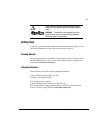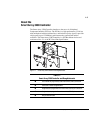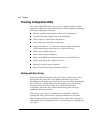
1-7
Compaq Smart Array 3200 Controller Reference Guide
Writer: Rickard Project: Compaq Smart Array 3200 Controller Reference Guide Comments: 340862-002
File Name: B-CH01.DOC Last Saved On: 12/7/98 8:24 AM
COMPAQ CONFIDENTIAL - NEED TO KNOW REQUIRED
Using Fault Tolerance
Fault tolerance refers to the protection of data if a hardware failure occurs in the
storage system. There are several methods for setting a system’s fault tolerance.
Understanding each of these methods is important in determining the best
method for the particular needs of your storage system. The fault-tolerance
methods supported by the Smart Array 3200 Controller and the Array
Configuration Utility include:
■ Distributed data guarding: RAID 5
■ Data guarding: RAID 4
■ Drive mirroring: RAID 1 or RAID 0+1 (also called RAID 10)
■ No fault tolerance: RAID 0
Further data protection can be achieved by assigning an online spare to any
RAID 1, RAID 0+1, RAID 4, or RAID 5 configuration. Refer to Appendix E
for more information on fault-tolerance methods. Refer to Chapter 5 for
information on using the Array Configuration Utility to configure your system
for fault tolerance.
Expanding or Extending Capacity
Changing your storage configuration is easy using the Array Configuration Utility
and does not require a data backup and restore cycle, even in fault-tolerant
configurations. If you are using Microsoft Windows NT or Novell NetWare
operating systems with hot-pluggable drives, storage expansion or extension can
be performed online, without shutting down the server’s operating system.
Capacity expansion refers to adding capacity and creating new logical drives.
Capacity extension refers to increasing the size of an array by adding physical
drives and growing an existing drive without adding more logical drives. For more
information on storage expansion or extension, see “Running the Array
Configuration Utility,” in Chapter 5, and the section, “Adding Storage Capacity”
in Appendix E.


















